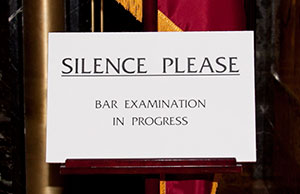Plunging law school admissions standards and bar exam passage rates

Four years ago, a movement to force law schools to disclose more accurate information regarding employment and salary outcomes for their graduates began to have some initial success. Not coincidentally, applications to law school started to drop, and, as more and more information became available, that drop accelerated, with the result that, by this fall, applicant totals were nearly 40% lower than in 2010.
Many schools responded by slashing admissions standards. The leaders in this race to the bottom were the for-profit Infilaw schools, and, predictably, that policy has already begun to be reflected in the bar passage rates of their graduates:
Bar-passage rates at the InfiLaw schools are now in a free fall. (The following percentages are for first-time takers of the July exam in the schools’ home states.) Florida Coastal’s bar-passage rate has fallen from 76 percent to 59 percent, Charlotte’s has fallen from 78 percent to 47 percent, and Arizona Summit’s has gone from 75 percent to an astonishing 30.6 percent.
But the Infilaw schools were merely a bit ahead of the curve:
It would be bad enough if the collapse of law-school admissions standards, and the subsequent collapse of bar-passage rates, were limited to a handful of especially egregious bad actors in the world of for-profit higher education. But as I argued last year, the same basic path followed by Infilaw is now being taken by dozens of other law schools, almost all of which are nonprofits. The only difference between these schools and the InfiLaw group is that most of them waited a year or two longer before reducing their admissions standards in response to plummeting application numbers, and that therefore it will take another year or two before this is reflected in the national bar-exam results.
A new report from the watchdog group Law School Transparency catalogs exactly how severe the bar-exam crisis is likely to become. The report documents the steep decline in admissions standards at American law schools, and concludes that last year more than one third of ABA-accredited schools admitted classes in which at least 25 percent of the admits are at significant risk for failing the bar. Roughly three dozen of these schools—nearly 20 percent of all ABA law schools—admitted classes in which half or more of the entering class is at a high risk of failing the bar, according to the report. (The latter total has more than quadrupled since 2010.)
The LST report, which is well worth reading in its entirety, reveals the extent to which a large minority of ABA law schools are now admitting classes with credentials that practically guarantee catastrophic bar exam failure rates for their graduates. As for what, if anything, various regulatory bodies are going to do about this, that remains to be seen:
The ABA accreditation standards require a school’s bar-passage rate to fall more than 15 points below the state average for at least three of the most recent five years before the school can even be considered for de-accreditation. Remarkably, the passage rate of the school’s own graduates is counted as part of the state average, meaning that, the larger the school, the more likely it is the high failure rate of its graduates can suppress the statewide bar passage rate enough to protect the school’s accreditation.
This is just one example of how the ABA committee that oversees law-school accreditation has been, as I argued last year, captured by the very institutions it is supposed to be regulating. At this point, it’s unclear whether plunging bar-passage rates will inspire federal regulators to take a more aggressive role in protecting both severely underqualified prospective law students and American taxpayers from the predatory behavior of many of the country’s law schools.
Now in a certain brutal social Darwinian sense, this series of developments is going to ameliorate, if not solve, the employment crisis among new law graduates. While the total number of law school matriculants hasn’t fallen nearly as quickly as the application pool, the willingness of more than a third of law schools to admit huge numbers of students who will never pass the bar means that, when the current classes graduate, the number of newly licensed lawyers looking for jobs will fall to perhaps 25,000 per year, down from around 42,000 in 2013. It’s a travesty that this beneficial reduction will take place, in part, because thousands of graduates who never had any realistic chance of obtaining a law license will be graduating with enormous non-dischargeable debts, borrowed from a government that did nothing to protect them from those who profited from preying on their dreams.


